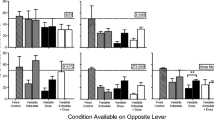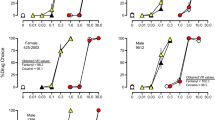Abstract
Rhesus monkeys were trained in a discretetrials choice procedure and allowed to choose between food delivery (1–16 pellets; 1 g/pellet) and intravenous injections of cocaine (0.03–0.56 mg/kg/injection;N=4) or procaine (1.0–10 mg/kg/injection;N=4) during daily 3-h sessions. Injections were available as the alternative to food. When the amount of food available as the alternative to drug was held constant and dose of drug was varied, the frequency of drug choice and total drug intake increased in a dose-related fashion for both cocaine and procaine. For both drugs, when the amount of food available as the alternative to drug was increased and the dose of the drug was held constant, the frequency of drug choice and total drug intake decreased. Thus, increases in the magnitude of an alternative non-drug reinforcer decreased cocaine and procaine self-administration. Further, the results suggest that while increasing the magnitude of the alternative reinforcer decreased the potency of cocaine as a positive reinforcer, the reinforcing efficacy of procaine was decreased. Because drug use by humans typically occurs in a context in which other reinforcers are available, the present results are consistent with the hypothesis that drug self-administration by humans can be decreased by increasing the value of alternative positive reinforcers. In addition, these results suggest that the extent to which drug self-administration is sensitive to this manipulation varies across drugs.
Similar content being viewed by others
References
Aigner TG, Balster RL (1978) Choice behavior in rhesus monkeys: cocaine versus food. Science 201:534–535
Bergman J, Johanson CE (1981) The effects of electric shock on responding maintained by cocaine in rhesus monkeys. Pharmacol Biochem Behav 14:423–426
Carroll ME, France CP, Meisch RA (1979) Food deprivation increases oral and intravenous drug intake in rats. Science 205:319–321
Carroll ME, Lac ST, Nygaard SL (1989) A concurrently available nondrug reinforcer prevents the acquisition or decreases the maintenance of cocaine-reinforced behavior. Psychopharmacology 97:23–29
Carroll ME, Lac ST, Asencio M, Kragh R (1990) Fluoxetine reduces intravenous cocaine self-administration in rats. Pharmacol Biochem Behav 35:237–244
Crowley TJ (1984) Contingency contracting treatment of drugabusing physicians, nurses, and dentists. In: Grabowski J, Stitzer ML, Henningfield JE (eds) Behavioral intervention techniques in drug abuse treatment. NIDA Research Monograph No. 46, US Government Printing Office, Washington, DC, pp 68–83
de Wit H, Wise RA (1977) Blockade of cocaine reinforcement in rats with the dopamine receptor blocker pimozide, but not with the noradrenergic blockers phentolamine or phenoxybenzamine. Can J Psychol 31:195–203
Dworkin SI, Mirkis S, Smith JE (1990) Reinforcer interactions under concurrent schedules of food, water, and intravenous cocaine. Behav Pharmacol 1:327–338
Fischman MW, Schuster CR (1982) Cocaine self-administration in humans. Fed Proc 41:241–246
Ford RD, Balster RL (1977) Reinforcing properties of intravenous procaine in rhesus monkeys. Pharmacol Biochem Behav 6:289–296
Griffiths RR, Brady JV, Snell JD (1978) Progressive-ratio performance maintained by drug infusions: comparison of cocaine, diethylpropion, chlorphentermine, and fenfluramine. Psychopharmacology 56:5–13
Griffiths RR, Brady JV, Bradford LD (1979) Predicting the abuse liability of drugs with animal drug self-administration procedures. In: Thompson T, Dews PB (eds) Advances in behavioral pharmacology, vol. 2. Academic Press, New York, pp 163–208
Griffiths RR, Bigelow GE, Henningfield JE (1980) Similarities in animal and human drug-taking behavior. In: Mello NK (ed) Advances in substance abuse, vol. 1. JAI Press, Greenwich, CT, pp 1–90
Grove RN, Schuster CR (1974) Suppression of cocaine self-administration by extinction and punishment. Pharmacol Biochem Behav 2:199–208
Hammerbeck DM, Mitchell CL (1978) The reinforcing properties of procaine andd-amphetamine compared in rhesus monkeys. J Pharmacol Exp Ther 204:558–569
Iglauer C, Woods JH (1974) Concurrent performances: reinforcement by different doses of intravenous cocaine in rhesus monkeys. J Exp Anal Behav 22:179–196
Johanson CE (1977) The effects of electric shock on responding maintained by cocaine injections in a choice procedure in the rhesus monkey. Psychopharmacology 53:277–282
Johanson CE (1978) Drugs as reinforcers. In: Blackman DE, Sanger DJ (eds) Contemporary research in behavioral pharmacology. Plenum Press, New York, pp 325–390
Johanson CE (1980) The reinforcing properties of procaine, chlorprocaine and proparacaine in rhesus monkeys. Psychopharmacology 67:189–194
Johanson CE, Aigner T (1981) Comparison of the reinforcing properties of cocaine and procaine in rhesus monkeys. Pharmacol Biochem Behav 15:49–53
Johanson CE, Fischman MW (1989) The pharmacology of cocaine related to its abuse. Pharmacol Rev 41:3–52
Johanson CE, Schuster CR (1975) A choice procedure for drug reinforcers: cocaine and methylphenidate in the rhesus monkey. J Pharmacol Exp Ther 193:676–688
Katz JL (1990) Models of relative reinforcing efficacy of drugs and their predicative utility. Behav Pharmacol 1:283–302
Meisch RA, Carroll ME (1987) Oral drug self-administration: drugs as reinforcers. In: Bozarth MA (ed) Methods of assessing the reinforcing properties of abused drugs. Springer, Berlin Heidelberg New York, pp 143–160
Mello NK, Mendelson JH, Bree MP, Lukas SE (1989) Buprenorphine suppresses cocaine self-administration by rhesus monkeys. Science 245:859–862
Roberts DCS, Koob GF, Klonoff P, Fibiger HC (1980) Extinction and recovery of cocaine self-administration following 6-hydroxydopamine lesions of the nucleus accumbens. Pharmacol Biochem Behav 17:901–904
Spealman RD, Goldberg SR (1978) Drug self-administration by laboratory animals: control by schedules of reinforcement. Annu Rev Pharmacol Toxicol 18:313–339
Stitzer ML, Bigelow GE, Liebson I (1980) Reducing drug use among methadone maintenance clients: contingent reinforcement for morphine-free urines. Addict Behav 5:333–340
Stitzer ML, McCaul ME, Bigelow GE, Liebson I (1983) Oral methadone self-administration: effects of dose and alternative reinforcers. Clin Pharmacol Ther 34:29–35
Vuchinich RE, Tucker JA (1983) Behavioral theories of choice as a framework for studying drinking behavior. J Abnorm Psychol 92:408–416
Vuchinich RE, Tucker JA (1988) Contributions from behavioral theories of choice to an analysis of alcohol abuse. J Abnorm Psychol 97:181–195
Wilson MC, Schuster CR (1972) The effects of chlorpromazine on psychomotor stimulant self-administration in the rhesus monkey. Psychopharmacology 26:115–126
Woolverton WL (1986) Effects of a D1 and D2 dopamine antagonist on the self-administration of cocaine and piribedil by rhesus monkeys. Pharmacol Biochem Behav 24:531–535
Woolverton WL, Balster RL (1981) Effects of antipsychotic compounds in rhesus monkeys given a choice between cocaine and food. Drug Alcohol Depend 8:69–78
Woolverton WL, Balster RL (1982) Behavioral pharmacology of local anesthetics: reinforcing and discriminative stimulus effects. Pharmacol Biochem Behav 16:491–500
Woolverton WL, Balster RL (1983) The effects of local anesthetics on fixed-interval responding in the rhesus monkey. Pharmacol Biochem Behav 18:383–387
Woolverton WL, Johanson CE (1984) Preference in rhesus monkeys given a choice between cocaine andd,l-cathinone. J Exp Anal Behav 41:35–43
Woolverton WL, Nader MA (1990) Experimental evaluation of the reinforcing effects of drugs. In: Adler MW (ed) Modern methods in pharmacology: testing and evaluation of drugs of abuse, vol. 6. Liss, New York, pp. 165–192
Yanagita T (1973) An experimental framework for evaluation of dependence liability in various types of drugs in monkeys. Bull Narc 25:57–64
Author information
Authors and Affiliations
Rights and permissions
About this article
Cite this article
Nader, M.A., Woolverton, W.L. Effects of increasing the magnitude of an alternative reinforcer on drug choice in a discrete-trials choice procedure. Psychopharmacology 105, 169–174 (1991). https://doi.org/10.1007/BF02244304
Received:
Revised:
Issue Date:
DOI: https://doi.org/10.1007/BF02244304




